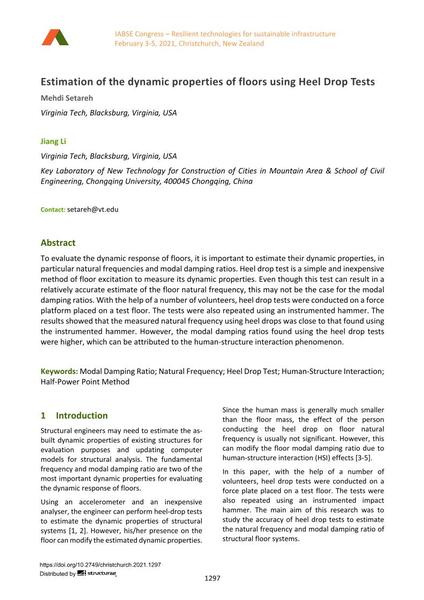Estimation of the dynamic properties of floors using Heel Drop Tests

|
|
|||||||||||
Bibliographic Details
| Author(s): |
Mehdi Setareh
(Virginia Tech, Blacksburg, Virginia, USA)
Jiang Li (Virginia Tech, Blacksburg, Virginia, USA; Key Laboratory of New Technology for Construction of Cities in Mountain Area & School of Civil Engineering, Chongqing University, 400045 Chongqing, China) |
||||
|---|---|---|---|---|---|
| Medium: | conference paper | ||||
| Language(s): | English | ||||
| Conference: | IABSE Congress: Resilient technologies for sustainable infrastructure, Christchurch, New Zealand, 3-5 February 2021 | ||||
| Published in: | IABSE Congress Christchurch 2020 | ||||
|
|||||
| Page(s): | 1297-1303 | ||||
| Total no. of pages: | 7 | ||||
| DOI: | 10.2749/christchurch.2021.1297 | ||||
| Abstract: |
To evaluate the dynamic response of floors, it is important to estimate their dynamic properties, in particular natural frequencies and modal damping ratios. Heel drop test is a simple and inexpensive method of floor excitation to measure its dynamic properties. Even though this test can result in a relatively accurate estimate of the floor natural frequency, this may not be the case for the modal damping ratios. With the help of a number of volunteers, heel drop tests were conducted on a force platform placed on a test floor. The tests were also repeated using an instrumented hammer. The results showed that the measured natural frequency using heel drops was close to that found using the instrumented hammer. However, the modal damping ratios found using the heel drop tests were higher, which can be attributed to the human-structure interaction phenomenon. |
||||
| Keywords: |
natural frequency human-structure interaction modal Damping Ratio Heel Drop Test Half-Power Point Method
|
||||
